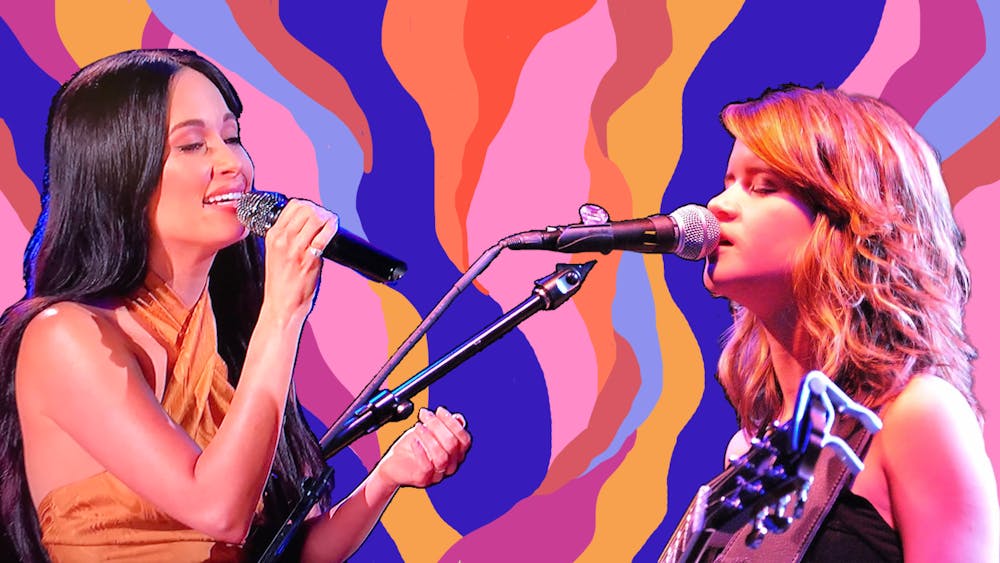Country music has been a staple of American culture for decades. Stars like Blake Shelton, Garth Brooks, and Tim McGraw have made names for themselves in this genre, singing about blue–collar life and the lifestyles of the American South.
As country veterans watched their careers peak, a newer generation of fresh blood has begun to fill in the gaps with their own takes. Chris Stapleton continued the styles of his predecessors while adding rock and soul to the genre. Kane Brown brought elements of R&B and trap beats into country, diversifying its soundscape. But while country music as a whole is progressing musically, it's still associated with the values and politics of its veteran stars, namely those of the conservative South.
In early September of this year, we saw this clash between the old and new country at its prime. Maren Morris, a relative newcomer to the industry, clapped back against country veteran Jason Aldean after Aldean’s wife posted a transphobic comment to Instagram. The two sides ignited an unprecedented feud over LGBTQ advocacy in country music, with drawing support for their stances, bringing into question: Does “y’all” really mean all?
For the majority of country music history, the answer is no. For decades, country has been dominated by white men. The music certainly reflects that, oversaturated with songs about beer, bros, and girls. Women comprise a small portion of country music, with racial minorities even less represented. A newer generation of artists is beginning to speak out about progressive issues in the industry, and have recently begun tackling the lack of diversity within the genre, particularly the lack of BIPOC representation.
Likewise, the number of LGBTQ country stars is far and few between. Only recently have some stars, like Ty Herndon, Billy Gilman, and Chely Wright, felt comfortable enough to come out. However, these artists only did so at the tail end of their careers, meaning that they saw less fallout as a result. The only out artists in mainstream country, like T.J. Osbourne from Brothers Osbourne or Brandi Carlile, have a smaller overall audience compared to the genre's big names.
The most successful country song in recent years is, arguably, “Old Town Road” by Lil Nas X featuring Billy Ray Cyrus. Yet, the song sparked debate as to whether was “country enough.” Billboard removed the song from its country charts, deeming it ineligible the same week it would’ve hit number one on the Hot Country Songs chart. Lil Nas X, a Black gay artist with also a hip–hop and rap background, does not fit the mold of a “typical” country artist. Perhaps this close–mindedness in the music industry could explain why the song was not considered to be “country enough.” But, several white country artists have used trap–inspired beats in their songs, such as Florida Georgia Line’s “Cruise” and Jason Aldean’s “Dirt Road Anthem.” Unlike “Old Town Road,” these are classified as country songs without question.
It’s not that no one in country music is advocating for marginalized groups. Dolly Parton is known for her advocacy in education, women’s rights, and LGBTQ rights. Her vocal support for these causes made her trailblazing figure, as she’s simultaneously been able to receive the respect of the industry while continuing to establish her legacy. Miranda Lambert, whose brother identifies as gay, uses her platform as a country veteran to speak for equality for the LGBTQ community. Brothers Osbourne won a Grammy Award for Best Country Duo/Group Performance in 2022 for “Younger Me,” a song about the younger Osbourne’s experience being in the closet.
However, there's only so much a newer star can do. A few days after Morris spoke out against the Aldeans, Brittany Aldean was a guest on Tucker Carlson Tonight, where Carlson referred to Morris as a “lunatic country music person.” While Morris used this situation to raise money for trans youth, it noticeably affected her popularity among key country music demographics. Likewise, while Morgan Wallen was blacklisted on country radio, the effects were only temporary. Recently, he made a comeback to country, signifying that saying racial slurs isn’t offensive to most country music fans.
What can country music do, then, to adapt to the changing times? Many have ignited the spark, but more needs to be done to keep the fuse lit. A wider, systematic inclusion of people of color and LGBTQ artists in mainstream country music should be a top priority. For example, country music in the Latino community incorporates influences of the Hispanic South and Mexican flair, diversifying its sound. Yet, it’s rarely ever played on the radio, and any references to the Latinx community in country rely on existing stereotypes. Incorporating these artists and sounds will make country music much better, richer, and more universal, perfecting complying with the genre’s core objectives.
There’s a long way to go to fully include minorities in a category of music long–dominated by a single group of people. At the end of the day, however, if the country industry wants to express “y’all” in its music, it must commit to including all.







